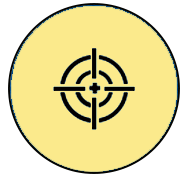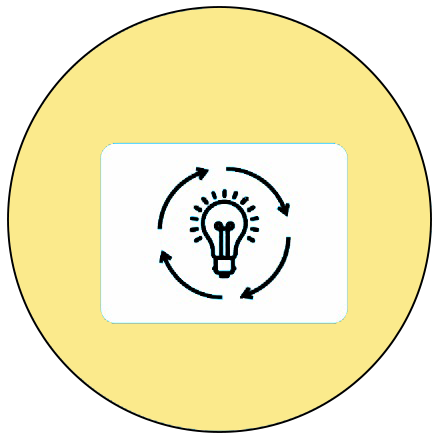
Measurement
Week 2 – Measure Weight
Learning Outcome
- Compares two objects in terms of their weight as heavier than or lighter than.
- Appreciates the need for a simple two-pan balance and compares weights of given objects using the simple two-pan balance.
 Objective
Objective
Children will be able to measure heavy and light objects using nonstandard objects and a two-pan balance scale.
 Prerequisites
Prerequisites
- Children can identify big or small and heavy or light objects around them.
- The teacher can use flashcards with big or small, heavy or light objects or real objects and ask the children to identify them by their size as big or small and by weight as heavy or light at the start of the lesson as a simple way to check their understanding.
 Pre-teach Vocabulary
Pre-teach Vocabulary
Children should be familiar with the terms big and small, heavy and light, weight, size, compare, and guess.
Introduction
Materials required:
- Objects: potatoes, chillies, pencils, crayons, school bag, tiffin box, pencil box, [any other objects available in and around the classroom].
- Flashcards with big and small objects
- Flashcards showing the heavy and light objects. (Without answers)
Revision – Measuring Length:
The teacher can start by recapping the previous week’s lesson on measuring length using hand and foot spans. The teacher then introduces the concept of measuring weight.
The teacher can call a child, give an apple and a tomato, and ask the child to hold the apple in one hand and the tomato in the other hand and ask the child to say aloud which one is heavy. Two objects – one heavy and one light – such as a book and a pencil, a school bag and a pencil case, or a notebook and a pen, can be given to a few more children. After guiding the children to feel, compare, and guess which object is heavier and which is lighter, the teacher can then show them two lemons and two tomatoes of almost the same size and ask them to guess which is heavier. Some may say the lemons, while others may say the tomatoes.
Teacher: Children, we are not sure whether 2 lemons are heavier or 2 tomatoes are heavier. But if we have a two-pan balance scale, we can measure the weight of two lemons and two tomatoes and find which is heavier.
The teacher can then show a flashcard of a two-pan balance scale. It is just like a seesaw. Children, now, watch this video.
Watch the Weight
Background: School playground. The teacher is standing with a group of children beside a seesaw, directing them.
Teacher: Raju, please sit on one side. Rosie, sit on the other side. Which side is down? Which is up?
Children: Rosie’s side is up, and Raju’s side is down.
Teacher: Good. You’re correct. The lighter side is always up, whereas the heavier side is always down. Now, Rani, you must sit alongside Rosie. [The seesaw falls on Rosie’s and Rani’s side and rises on Raju’s side.] Children, please tell me which side is up and which is down.
Children: Rosie’s and Rani’s side is down; Raju’s side is up.
Teacher: Yes. Very good. Rosie and Rani together weigh more than Raju. Subhu, you are now sitting with Raju. Now, which side is higher and which is lower?
Children: Both sides are equal, teacher. We are confused.
Teacher: Yes. The weight of Rosie and Rani is equivalent to that of Raju and Subhu. They are balanced.
Video: Watch the Weight – Coming soon
ISL Video: Watch the Weight – Coming soon
Teacher: Come, let us go to the playground and learn to measure the weight. Take turns to sit on either side of the seesaw, try and find who weighs more, who weighs less, and how to balance the weight on both sides. The teacher allows the children to explore independently while providing supervision.
Teacher: Everyone Come. We’ll go to our class and do some measurement exercises using nonstandard objects and standard measures.
The teacher proceeds to engage the children in weight measurement activities.
Activity 1: Heavy Measuring Weight with Nonstandard Objects
Objective: To measure the weight of objects in terms of equal sized blocks.
Importance of the activity for children:
Helps in developing:
- Fine motor skills (Holding the balance, hand-eye coordination)
- Gross motor skills (Sitting, bending, and writing)
- Cognitive skills (Problem solving, comparing and identifying the heavy and light objects, and concentration)
- Social skills (Waiting for their turn to submit)
- Language skills (Concept formation like ‘heavy, heavier, heaviest’ and ‘light, lighter, lightest’)
- Emotional skills (Promotes a sense of achievement that boosts self-esteem and encourages pride in learning new skills)
Resources required:
Lots of equal-sized blocks, two two-pan balance scales (2 in number), 2 toy cars, 2 apples, 2 potatoes, and 2 chocolate bars. [Or any other 4 small measurable objects which children can handle]
Setting for the activity:
The activity can be done indoors.
Type of activity: Group activity
Preparation of activity:
Ensure that the required resources are kept ready.
Procedure:
- Organise the class into two groups.
- Provide each group with one ‘two-pan measuring scale’ and plenty of equal- sized blocks.
- Provide each group with a toy car, an apple, a potato, and one chocolate bar.
- To demonstrate, the instructor can place a notebook on one side of the scale and the blocks on the other, then determine how many blocks the notebook weighs.
- And write on the board, ‘The notebook weighs 12 blocks’.
- Instruct the group to measure the 4 given objects in relation to the blocks and record the result in a sheet.
Role of the teacher: Demonstrator, observer and facilitator.
Observations:
Observe the exercise to see if the children can weigh the objects in terms of blocks. If the children are having difficulty in completing the measuring task, the teacher can assist them.
Suggested Variations:
The number of objects to be measured, as well as the measuring object, can be varied, and the task can be completed individually.
Conclusion:
Children can measure the weight of different objects with other objects.
To reinforce the concept learned through the activity, the following video can be shown to the children.
Video: Measuring weight with nonstandard objects – Coming soon
ISL Video: Measuring weight with nonstandard objects – Coming soon
Activity 2: Guess the Weight to Get a Score
Objective:
To use the two-pan scale to understand heavier, lighter, and balanced weights of objects.
Importance of the activity for children:
Helps in developing:
- Fine motor skills (Holding the objects, hand-eye coordination, talking)
- Gross Gross motor skills (Balancing the measure)Skills (Run around)
- Cognitive skills (Problem solving, concentration)
- Social skills (Waiting for their turn, appreciating others)
- Language skills (Concept formation like ‘heavier and lighter’)
- Emotional skills (Promotes a sense of achievement that boosts self-esteem and encourages pride in learning new skills)
Resources required:
- A two-pan measuring scale
- Small and big objects like pens, pencils, small pebbles, marbles, etc.
Setting for the activity:
The activity can be done indoors.
Type of activity: Group activity
Preparation of activity:
The teacher should ensure that a sufficient number of heavy and light objects are collected and kept ready. A two-pan weighing scale should be kept on the table.
Procedure:
- Organise the class into two groups.
- Leave the two-pan measuring scale on the table. Let the two groups stand on each side of the table.
- Assign a few items to the first group and a few to the second group.
- The first group will place a few items in one pan and ask the second group to place heavier things in the other pan in one guess.
- If the second group succeeds, the pan on the first group’s side will go up. The second group receives one score. If they do not guess right, the pan on their side will be light, and they will lose, with no score given.
- Both groups repeat the game again, with the first group getting 10 chances to place the objects and the second group guessing the weight, heavier or lighter, as specified by the first group.
- The groups then switch roles.
- The second group places the items on one pan and challenges the first group to put the items on the other pan to make it heavier or lighter, as specified in one guess.
- The second group also gets 10 chances.
- The group with the highest score is declared the winner.
- Encourage children to clap for each other.
Role of the teacher: Demonstrator, observer and facilitator.
Observation:
The teacher can observe the exercise to assess children’s teamwork and cooperation skills.
Handling things and guessing their weight helps children understand the concept of ‘heavy, heavier, light, and lighter.’
Suggested variation in the activity:
If sufficient two-pan balance scales can be arranged, the activity can be done in pairs.
Conclusion:
Children can learn to estimate the weight of objects. Children will also develop teamwork skills.
Assessment: Measuring Weight
The teacher can give the following assessment worksheets, A and B, to the children to assess their understanding of the concept of measuring weight.
Worksheet: Assessment – Colour the heavy objects – Coming soon
Worksheet: Assessment – Colour the heavy objects (Enlarged) – Coming soon
Worksheet: Assessment – Which is heavier? Which is lighter? – Coming soon
Worksheet: Assessment – Which is heavier? Which is lighter? (Enlarged) – Coming soon
Check list for teacher:
| Activity | Yes | No | Sometimes |
| Children can: | |||
| Identify big and small objects | |||
| Identify heavy and light objects | |||
| Comapre and guess the weight of objects | |||
| Understand that the size and weight of objects are not always directly connected | |||
| Complete the activity in the given time | |||
| Do the activity independently | |||
| Express through verbal articulation, actions, expressions or gestures | |||
| Enjoy teamwork, appreciates others, and is willing to learn from others |
Home Activity
To reinforce the concepts learned in the class, the following worksheets can be given to children to complete at home. The teacher can follow it up the next day.
Home Activity 1: Printable Worksheets – Colour as instructed.
Home Activity 2: Printable Worksheets – Complete the sentences using one of the words: Heavier, Lighter, Balanced—in the worksheet.
Worksheet: Colour as instructed – Coming soon
Worksheet: Colour as instructed (Enlarged) – Coming soon
Worksheet: Complete the sentences – Coming soon
Worksheet: Complete the sentences (Enlarged) – Coming soon
Cross-Curricular Connection:
- Art class:
- Children may be asked to draw images of balanced and imbalanced scales with appropriate objects (in weights) on both pans.
- Children can be asked to draw a set of three images in the ascending and descending order of the weight of the objects: Heavy – Heavier – Heaviest; Light – Lighter – Lightest
- English class:
- Children can be given different objects of different sizes and weights.
- Children are asked to compare the weights of objects given
- Children will learn degrees of comparison: Heavy – Heavier – Heaviest; Light – Lighter – Lightest
- EHV Class
- Children are given small but heavy objects and big but light objects
- Children learn that size and weight are not always related
- Children will learn not to judge by looking at the externals
Adaptations for addressing learner variability: Adaptations and strategies – Coming soon
Teacher Resource Document – Coming soon
| Source and Attribution of images: All images used in the above Assets and Aids are originally created. |
| This digital material has been developed by the Sri Sathya Sai Vidya Vahini Inclusive Education Project, a unit of Sri Sathya Sai Central Trust, Prasanthi Nilayam, as a collaborative offering in the service of our nation. |